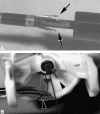Neurointerventional experience with an arteriotomy suture device
- PMID: 10543645
- PMCID: PMC7056203
Neurointerventional experience with an arteriotomy suture device
Abstract
We describe our experience with an arteriotomy closure device that has become a routine tool for the management of most patients in our neurointerventional service. In our experience, this device contributes significantly to patient comfort by allowing mobilization within 2 hours of a procedure, even with anticoagulants. Efficacy and safety of this suture device requires proctoring during initial experience.
Figures





Similar articles
-
Safety and efficacy of a 6 French perclose arterial suturing device following percutaneous coronary interventions: a pilot evaluation.J Invasive Cardiol. 2002 Dec;14(12):741-5. J Invasive Cardiol. 2002. PMID: 12454337
-
Initial experience using Prostar: a new device for percutaneous suture-mediated closure of arterial puncture sites.Cathet Cardiovasc Diagn. 1996 Apr;37(4):367-72. doi: 10.1002/(SICI)1097-0304(199604)37:4<367::AID-CCD5>3.0.CO;2-9. Cathet Cardiovasc Diagn. 1996. PMID: 8721692
-
[First experience with the use of a clip device for closure of arterial approach after endovascular treatment of coronary arteries].Kardiologiia. 2008;48(1):15-8. Kardiologiia. 2008. PMID: 18260990 Russian.
-
Current developments in percutaneous arterial closure devices.Ann Vasc Surg. 2000 Nov;14(6):683-7. doi: 10.1007/s100169910123. Ann Vasc Surg. 2000. PMID: 11128469 Review. No abstract available.
-
Angioplasty and stenting in the carotid and vertebral arteries.Postgrad Med J. 1998 Jan;74(867):7-10. doi: 10.1136/pgmj.74.867.7. Postgrad Med J. 1998. PMID: 9538479 Free PMC article. Review.
Cited by
-
The safety and efficacy of the Angio-Seal closure device in diagnostic and interventional neuroangiography setting: a single-center experience with 1,443 closures.Neuroradiology. 2007 Sep;49(9):739-46. doi: 10.1007/s00234-007-0249-6. Epub 2007 Jun 27. Neuroradiology. 2007. PMID: 17594084
-
Prospective comparison of angio-seal versus manual compression for hemostasis after neurointerventional procedures under systemic heparinization.AJNR Am J Neuroradiol. 2013 Feb;34(2):397-401. doi: 10.3174/ajnr.A3226. Epub 2012 Aug 2. AJNR Am J Neuroradiol. 2013. PMID: 22859279 Free PMC article. Clinical Trial.
-
An evaluation of immediate sheath removal and use of the Angio-Seal vascular closure device in neuroradiological interventions.Neuroradiology. 2006 Jan;48(1):45-9. doi: 10.1007/s00234-005-0013-8. Epub 2005 Oct 28. Neuroradiology. 2006. PMID: 16261336
-
Transcervical access via direct neck exposure for neurointerventional procedures in the hybrid angiosuite.Neuroradiology. 2018 May;60(5):565-573. doi: 10.1007/s00234-018-1994-4. Epub 2018 Mar 1. Neuroradiology. 2018. PMID: 29497785
References
-
- Dion JE, Gates PC, Fox AJ, et al. Clinical events following neuroangiography: a prospective study. Stroke 1987;18:997-1004 - PubMed
-
- Olivecrona H. Complications of cerebral angiography. Neuroradiology 1977;14:175-181 - PubMed
-
- Uchino A. Local complication in transbrachial cerebral angiography using the 4-F catheter. Neurolo Med Chir (Tokyo) 1991;31:647-649 - PubMed
-
- Millward SF. Letter to the editor: Routine transbrachial angiography. Radiology 1989;172:577 - PubMed
-
- Fruhwirth J, Pascher O, Haufer H, Amann W. Local vascular complications after iatrogenic femoral artery puncture. Wiener Klinische Wochenschrift 1996;108:196-200 - PubMed
MeSH terms
LinkOut - more resources
Full Text Sources
